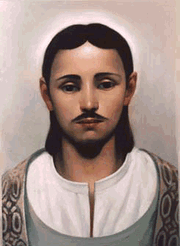 The circled cross represents the divided nature of the universe between the World of Light and the World of Darkness. | |
| Founder | |
|---|---|
| Mani | |
| Scriptures | |
| The Evangelion |
Manichaeism is a religion developed by Mani of Mesopotamia during the mid 3rd century A.D., who claimed to have the ultimate truth about the universe. His teachings were not very popular during his life, but after his death the number of adherents quickly grew in Mesopotamia and beyond. Within a hundred years of Mani's death, Manichaeism had spread as far apart as Hispania to China, briefly becoming the main rival against Christianity for religious dominance within Europe and Asia.
Presently Manichaeism exists as mostly a minority religion, with its largest concentrations in Mesopotamia, Persia, Arabia, and Persia. However, it has millions of adherents throughout the world and has survived numerous and current persecutions against its practice.
Theology[]
Basic Principles[]

A European depiction of Mani from the late-20th century.
As espoused by Mani, Manichaeism claims to be the final revelation from God to the world. The religions of Zoroastrianism, Buddhism, and Christianity were all previous attempts at revealing that revelation, but were ultimately incomplete. As a result, Manichaeism usually has better perceptions towards these religions compared to others, although relations with these religions has also varied in the past based on levels of persecution.
Mani adopted a largely gnostic view of the world, incorporating elements from the aforementioned religions. He suggested that there were two deities present in the universe, one good and one bad. The good god is responsible for what is spiritual and positive while the evil god created what is physical and negative. These two gods are locked in an eternal battle for the fate of the universe. By living positive lifestyles and rejecting base sins and materialistic goals, individuals are able to leave the world of darkness (the physical world) and join God in the world of light (heaven).
Worship[]
Scripture[]
The main holy scripture of Manichaeism is the Evangelion, which is a collection of Mani's various writings and the writings of his closest followers. For the large part, the Evangelion has been unchanged for thousands of years, although there are several inconsistencies and varying interpretations of its meaning. The Evangelion can be divided into the following parts:
- The Ardahang
- The Treasure of Life
- The Treatise
- Secrets
- The Book of Giants
- Letter of Foundation
- The Kephalaia of the Teacher
- Psalms and Prayers
Priesthood[]
Those that believe in Manichaeism occupy two categories: the Electi, or those that have taken vows, and the Hearers, those who believe but have not become clergy. The clergy is headed by the Supreme Leader, the equivalent of a Christian pope or patriarch. Beneath him the faith is administered by 72 bishops and 360 presbyters, both of which are aided by a larger and theoretically limitless number of priests, monks, and nuns. In modern times, one of the major questions in the Electi is whether the number of bishops and presbyters should be expanded to accommodate the larger population of Manichaeans throughout the world.
Places of Worship[]

The Cao'an Temple in China, an example of a Manichaean temple still in use today.
Manichaeans worship in temples, of which there is no real regulation or organization of hierarchy. As such, temples occupy a wide range of sizes and styles. The largest such temple is present in Ctesiphon as the head of the Supreme Leader. Other places of worship exist as well such as monasteries and nunneries, although these are considerably less common than regular temples. Shrines also exist throughout the countryside of Manichaean-majority areas.
